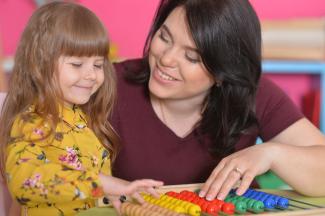
The State of Preschool Yearbook 2021
Summary


The State of Preschool 2021 annual report covers the 2020-2021 school year, the first school year fully impacted by the COVID-19 pandemic. The pandemic created difficulties such as health risks, closed classrooms, and remote preschool that disrupted already fragile systems. Enrollment declined by 18%, the first decrease in preschool enrollment in two decades. Preschool spending decreased too, but not as dramatically because many states protected preschool funding despite lower enrollments and preserved capacity for a rebound in enrollment. States also utilized federal funding, including pandemic relief funds to support preschool. Quality remains a concern as most states spend too little per child to provide a high quality program, and states relaxed standards during the pandemic.
Across the 44 states, DC, and Guam that funded a preschool program in 2020-2021, 29% of 4-year-olds and 5% of 3-year-olds were enrolled, a substantial decrease from pre-pandemic levels, erasing a decade of growth in preschool enrollment. Three state-funded preschool programs made changes to gain an additional benchmark for minimum quality standards (KS, UT, WA ECEAP). State funding for preschool fell by $254 million (adjusted for inflation) but spending from all sources increased. State preschool spending per child remains essentially the same as two decades ago, adjusting for inflation, below $6,000.
In the report, NIEER lays out policy recommendations for states and the federal government to expedite increased access to high-quality, full-day preschool.
Profiles
-
Alabama
Alaska
Arizona
Arkansas
California
Colorado
Connecticut
Delaware
District of Columbia
Florida
Georgia
Hawaii
Idaho
Illinois
Indiana
Iowa
Kansas
Kentucky
Louisiana
Maine
Maryland
Massachusetts
Michigan
Minnesota
Mississippi
Missouri
Montana
Nebraska
Nevada
New Hampshire
New Jersey
New Mexico
New York
North Carolina
North Dakota
Ohio
Oklahoma
Oregon
Pennsylvania
Rhode Island
South Carolina
South Dakota
Tennessee
Texas
Utah
Vermont
Virginia
Washington
West Virginia
Wisconsin
Wyoming
Suggested Citation
Friedman-Krauss, A. H., Barnett, W. S., Garver, K. A., Hodges, K. S., Weisenfeld, G., Gardiner, B. A., Jost, T. M. (2022). The State of Preschool 2021: State Preschool Yearbook. New Brunswick, NJ: National Institute for Early Education Research.